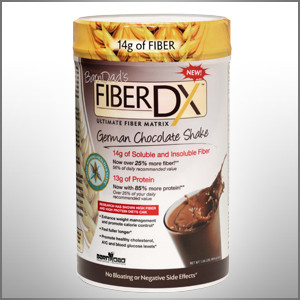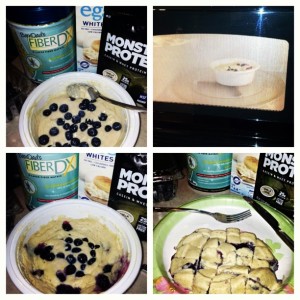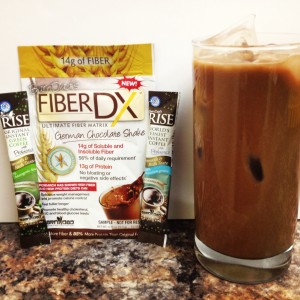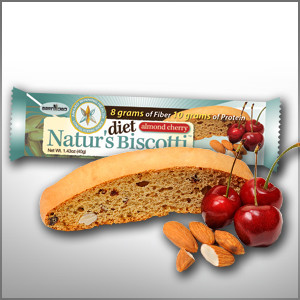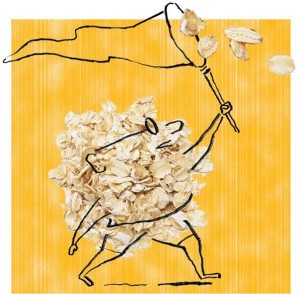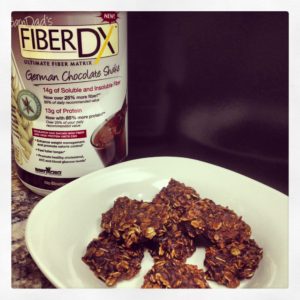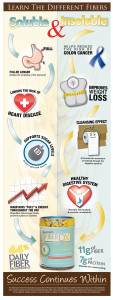To read more about studies that the University has done on dessert and weight loss, be sure to check out this article.
BarnDad’s Vanilla Blueberry Recovery Pie
When was the last time you had PIE without feeling guilty? Try this recipe for Vanilla Blueberry Recovery Pie. You will love this recipe as it keeps your blood sugar in control, helps build lean muscle and tastes great! At only 268 calories, you are receiving 35 grams of protein, 11 grams of fiber and only 4 grams of fat. Healthy and quick to make!
Recipe:
1 full scoop of BarnDad’s FiberDX
1 packet or 1 scoop of a good vanilla flavored casein protein (25 grams protein)
1/4 cup of water
2 Tbs of liquid egg whites
1/4 cup of blueberries
Mix all ingredients except blueberries in a small plastic microwaveable bowl until content is mixed and looks like a pudding texture. Now add blueberries on top of the mix and place bowl in microwave on high for 90 seconds to cook. Pull out and let cool for 30 seconds in bowl. Now flip plastic bowl so that the base of PIE faces up. Cut and enjoy a tasty night of recovery! It’s awesome nutrition!
For more great recipes using BarnDad’s products, be sure to check out BarnDad’s Recipe Book.
BarnDad’s Iced Mocha
Looking for something that is going to give you some energy to get through the work day, tastes great and is healthy for you? Why not trying making BarnDad’s Iced Mocha?! It’s the perfect drink to give you that energy boost that you need, is easy to make and tastes great! Not only are you having a delicious drink, you are also adding fiber and probiotics into your diet!
Recipe:
Ingredients
-1 Stick BarnDad’s Rise Coffee
-¼ Boiling Water
-1 Scoop BarnDad’s FiberDX German Chocolate Shake
-½ Cup Milk Of Choice
Directions
-Combine coffee and boiling water. Stir well.
-Combine CFDX and almond milk in shaker. Mix well.
-Add coffee mixture and ice to shaker of CFDX/almond mixture.
-Mix well. Strain. Enjoy!
For more great recipes using BarnDad’s products, be sure to check out BarnDad’s recipes.
Are Your Protein Bars Filled With Sugar?
Did you know that today’s fiber and protein bars typically have between 12 – 25g of sugar?! Today’s health conscious consumer is looking for high protein and high fiber grab and go snacks, but is often unaware that with high sugar content we are basically eliminating the health benefits!
High sugar content will cause your blood sugar to spike quickly and drop your blood sugar just as quick. When your blood sugar is high your body releases insulin, which, if done on a regular basis can lead to diabetes.
Once the body’s blood sugar drops we begin to feel hungry again… so eating a protein or fiber bar that we mistakenly thought was “good for us’ will have bad effects on the body.
Consider the amount of sugar in your protein bar the next time you go to grab a snack! There are good, healthy options out there such as Natur’s Diet Biscotti. Natur’s Diet Biscotti has 8g of fiber and 10g of protein with only 1g of sugar!
Feed your Boomer body better – USA Weekend Magazine
Posted in: USA Weekend Magazine, Health Articles, The Doctors
By The Doctors / Casey Shaw | Aug 15, 2013
Baby Boomers have the longest life expectancy of any generation thus far; they’re also believed to be the most active generation. But a new study out of West Virginia University School of Medicine may tarnish that healthy reputation: Researchers found this aging group to have higher levels of hypertension, diabetes and high cholesterol, and higher rates of disability, than the generation that came before them. Obesity was also found to be more common among Baby Boomers — born between 1946 and 1964 — than their parents, which can affect quality of life and increase the chances of developing heart disease, stroke, certain cancers, osteoarthritis and other diseases. Good nutrition can help reduce the risk of many of the health conditions that are plaguing Boomers. Start with the basic dietary guidelines: Eat more fruits, vegetables, whole grains, fat-free and low-fat dairy products, lean proteins and seafood; limit unhealthy fats, added sugars and refined grains. Here are three more diet strategies to help keep Boomers strong and healthy into their golden years:
Consume more fiber.The list of benefits is long: Soluble fiber found in beans, oats, flaxseed and oat bran may help lower total blood cholesterol levels as well as slow the absorption of sugar and help improve blood sugar levels. High-fiber diets also can normalize bowel movements and may help with weight control. And according to a recent review of past research, people who eat foods that are particularly rich in cereal fiber or mixtures of whole grains and bran may be less likely to develop diabetes or heart disease. The daily fiber recommendation for men ages 51 and older is 30 grams; women in the same age group, 21 grams. Most Americans get only about 15 grams a day..
To read the article in it’s entirety, be sure to go to USAWeekend.com
Chocolate Banana Clusters with BarnDad’s German Chocolate Shake!
Have you been looking for a way to have dessert and not feel guilty? Why not try baking with BarnDad’s FiberDX and BarnDad’s FiberDX German Chocolate Shake! BarnDad’s FiberDX products are great to bake with and an easy way to add fiber/protein to your diet. Here is a QUICK and DELICIOUS recipe for Chocolate Banana Clusters using BarnDad’s FiberDX German Chocolate Shake!
Ingredients:
– 2 Bananas
– 1 Cup of Oats (Original or Instant; Either works)
– 2 Scoops of BarnDad’s FiberDX German Chocolate Shake
Directions:
– Combine all three ingredients in a medium size mixing bowl.
– Use a fork or large mixing spoon to mash the ingredients together. Mash until all of the ingredients are able to mold together (Little chunks of bananas are okay).
– Add cooking spray to your cookie sheet, then place little balls of the combined mixture on cookie sheet (Should get 15 cookies, depending how big you make your cookies).
– Bake for 15 minutes at 350 Degrees.
– Let cool & ENJOY!
For more recipes using BarnDad’s FiberDX products, be sure to check out http://barndadnutrition.org/recipes
FIBER PUMP!
Did you happen to see the July 2013 Issue of Muscle & Body? There is a must read article called “Fiber Pump!” that goes into detail about all of the great benefits of fiber, why it is necessary to add to a nutritional diet and also promotes BarnDad’s FiberDX as a must product for your diet! Below is a brief blurb of the article:
Ignore fiber at your peril. Here are the six reasons why you need it for muscle and strength gains.
Bodybuilders are notoriously strict about their diets. Searching for optimum results, they meticulously monitor their caloric intake, develop precise nutrition plans that leave little room for deviation, and analyze product labels like English professors deconstruct old novels. While most of the populous simply consumes whatever they feel like, bodybuilders are eating for a purpose—and their diets reflect it. Despite all this effort, however, a majority of bodybuilders ignore one of the easiest and healthiest ways to help maximize muscle gain: proper fiber intake.
Why Dietary Fiber is Crucial
Dietary fiber is basically the portion of plant-based foods that can’t be regularly digested by the human body. Found in high amounts in grains, beans, fruits, and darker green vegetables, dietary fiber’s primary benefits come from its ability to help the body more efficiently consume other nutrients, as well as cleanse the body of unwanted toxins.
This dietary fiber comes in two different forms: soluble and insoluble. Soluble fibers are beneficial because they swell upon contact with water, expanding to capture unabsorbed dietary fats and cholesterol. These soluble fibers also improve immunity and gastrointestinal health by supporting the production of beneficial bacteria while preventing harmful bacteria from gaining a foothold in the human system.
Insoluble fibers increase the water content and bulk of human waste product, making for enhanced motility and more regular elimination. (Yup, it helps you poop easier.) This helps any unwanted carcinogens more easily escape the body, which is the primary reason those with a diet high in fiber tend to have lower cancer rates.
How To Fix the Fiber Hole in Your Diet
Let’s face it, when most people think of fiber, they visualize a drink that looks suspiciously like wet sawdust that their grandmother used to force down with a shiver just before throwing in her dentures. But fiber has come a long way in just the last decade. The best ways for bodybuilders to bump up their fiber consumption are to add great-tasting foods such as whole-wheat pastas, beans, fruits, green vegetables, nuts and brown rice. But if your diet won’t allow all 60 g of fiber to come through dietary sources, there are some great fiber supplements on the market as well. One example of a leading sports-nutrition fiber supplement is BarnDad’s FiberDX, which provides a blend of both soluble and insoluble fibers. (Most fiber supplements are primarily one or the other.) The blend of fibers helps cut down on side effects sometimes associated with fiber supplements. It also includes 7 g of protein per serving. (Remember the wingman thing.)
Whatever source you choose, don’t skimp on fiber. It might just be the hidden edge you need to get the definition, mass and strength you’ve always wanted.
To read the article in it’s entirety, be sure to click here: Muscle & Body: Fiber Pump!
Health Boost From New Forms Of Dietary Fiber
High-fiber foods are on the way to becoming tastier and more appealing to consumers thanks to new types of dietary fiber now under development. These consumer friendlier forms of fiber, which could be a boon to health, are the topic of an article in the current issue of Chemical & Engineering News (C&EN), ACS’ weekly newsmagazine.
C&EN Associate Editor Jyllian Kemsley notes that dietary fiber plays key roles in human health. Fiber creates a feeling of fullness that can reduce calorie intake, and provides an energy source for beneficial bacteria in the digestive tract. Studies link high fiber diets to a reduced risk of diseases such as diabetes and colon cancer. However, Americans on average eat only about 15 grams of fiber per day, barely half the recommended amount. Getting consumers to eat more fiber can be difficult, particularly when people find some high-fiber foods unpalatable, Kemsley notes.
Scientists and food manufacturers are hoping that a new type of food fiber, called digestion-resistant starch, will help boost fiber intake without agitating the palate. Some scientists are trying to produce these new fibers by heating or chemically altering existing starches. Others are focusing on engineering plants, such as wheat and rice, so that they can produce these fibers naturally. One study found that when a group of men ate pieces of white bread containing a form of the new fiber, their blood glucose and insulin levels dropped by nearly half.
ARTICLE: “New Fibers for Foods”
Source:
Michael Bernstein
American Chemical Society
To read more on this article, be sure to check out Chemical & Engineering News.
The Difference Between Soluble Fiber and Insoluble Fiber
Fiber is not only an essential part of the daily diet, it is important in maintaining a healthy weight, as well as helping to control blood sugar and lowering your risk of diabetes and heart disease. Jeannie Gazzaniga-Moloo, Ph.D., R.D., spokesperson for the Academy of Nutrition and Dietetics, recently stated, “fiber’s benefit package includes the maintenance of a healthy digestive tract, helping to reduce the risk of heart disease and cancer, and helping to maintain healthy blood sugar levels and healthy weight.”
Incorporating the right amount of fiber into your diet means understanding the difference between soluble fiber and insoluble fiber. Soluble fiber is able to dissolve in water and passes through the body while absorbing other toxins, bad cholesterol and sugars. Insoluble fiber is what we usually think of as “roughage”. Wheat bran, vegetables, nuts, and seeds are examples of sources of insoluble fiber. Insoluble fiber is not easily broken down, and will pass through the intestine intact, helping the digestive system to function properly.
Sadly, many Americans do not get nearly enough fiber in their diets. Health experts recommend a minimum of 25 or more grams of fiber per day. It can be difficult to get enough fiber in one’s diet without adding in more calories, carbs and sugars than wanted. It is for this reason that supplementation can be important. One serving of BarnDad Innovative Nutrition’s premium fiber supplement, BarnDad’s FiberDX, provides 11 grams of fiber – that’s 44 percent of your recommended daily fiber intake!
BarnDad’s FiberDX is a 100% natural, time-release, soluble and insoluble fiber matrix that naturally reduces hunger and supports healthy weight management, lean muscle and a healthy digestive system. Using this proprietary blend of soluble and insoluble fiber helps you to feel pleasantly full, not bloated like many of the traditional fiber supplements available in today’s market.
Because both soluble and insoluble fibers are important for health, digestion and disease prevention, it is important that you get the right balance of both. A premium fiber supplement like BarnDad’s FiberDX will give you the proper blend of fibers that your body needs, while also providing you with all the health benefits associated with a high fiber diet.
GROW FINER WITH FIBER
Posted in: Articles by ProSource, Featured Content, Diet Articles, Supplement Articles
By ProSource Product Research Team | Jun 14, 2012
First Class Fiber Can Be the Secret Ingredient to a Better Physique
As an athlete dedicated to your diet, physique and exercise regimen, you certainly have spent a great deal of time and energy counting carbohydrates and protein. Amazing amounts of helpful information have come from science labs and athletes across the country telling us how much of these nutrients to eat. Every bodybuilder or physique athlete knows that consuming a diet which facilitates fat burning and increasing levels of leanness requires more than just the right balance of carbohydrates, protein and fat. One of these nutrients that can help you achieve those nutritional goals, while ripping up your physique, is dietary fiber. While dietary fiber is best known for its health effects (which are too great to pass over), the inclusion of high quality fiber throughout your diet can help your body to burn more fat and control your appetite as well as manage glucose and insulin levels.
Just so we’re clear, we’re not talking your grandma’s fiber supplement, we’re talking about a unique, high-end blend of fiber along with added protein. Dietary fiber comes in two forms, soluble and insoluble (Anderson, Baird et al. 2009). The soluble form dissolves in water and can bind to fat, which goes on to improve cholesterol and blood glucose levels while also removing fat from the digestive system. The insoluble form is not readily digested and as a result primarily adds bulk to the stool in your colon. If research holds true, you likely aren’t consuming enough fiber. The USDA recommends you to consume 14 grams of fiber for every 1,000 calories you consume in your diet; the average American male should strive to consume around 36 grams of fiber each day (USDA 2005).

